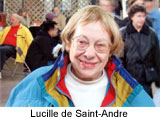 To celebrate the opening-season production of its 25th
anniversary the valiant Toronto Operetta Theatre offered the
charming Countess Maritza, much beloved by Europeans and
generally young-at-heart operetta goers who remember it from
performances in the old country.
Said one handsome white-haired gent: "I saw it in Hungary 50
years ago and it was far more realistic, showing a village
setting and all that."
A smash hit at its premiere in Vienna in 1924, composer Imre
KŠlmŠnís lovely tunes mix Viennese elegance with Hungarian
passion to show an impoverished but upright nobleman fall in
love with a proper rich and beautiful countess.
Some may long for the vanished splendor of a pre-World War One
where wealthy aristocrats danced the night away at Maximís in
Paris-- but today in Toronto time TOTís artistic director
Guillermo Silva-Marinís who also did lighting design, set decor,
and choreography, symbolized a more realistic time-frame.
A story line that could have easily followed an uncomplicated
romantic path of similar operatic farce turns to fortune
telling, prophesy and fate to settle matters of the heart. Of
course, as in all operettas, a "noble name" is very important
and can hardly be avoided.
Says director Silva-Marin: "I wanted to highlight the power we
humans give to augury or divination through symbolism and accent
this with dreamlike sequences in monochrome of black."
So, instead of traditional village settings we see minimal
settings with poles hung with giant tarot cards and the gypsy
Manja (sung by splendid coloratura Amanda Jones) opening in Act
I with the aria, "Fair of face the man and full of kindness,
bearer of a noble name" predicting loveís outcome after a full
moonís turn (four weeks).
So we have two surreal scenes (with the Act I finale and the Act
II finale with the entire cast in black and the lights low)
directly connected with the gypsyís foretelling of a happy love
ending.
In opera and operetta we depend on great voices but it does no
harm when the singers are tall, thin and attractive as is the
case in the Countess. (I once saw a Lohengrin at the New York
Met where the star appeared with glorious curls in a screen
projection and then descended from the boat on the stage
revealing a square short figure of heft and my heart only soared
again when he departed from his boat onto the screen, again
showing his glorious curls.)
![David Curry as Tassilo and Lara Ciekievicz as Countess Maritza [TOT production photo]](1001c-luc-63_small.jpg) The singing was uniformly great. Both leads are seen here for
the first time and both produced loverís magical chemistry in
solo duets on stage. Soprano Lara Ciekiewicz lovely Maritza, as
wealthy independent-thinking society lady escaping her suitors
to her country estate, sang and waltzed in a dizzying way,
confounding those of us who canít even walk and chew gum, and
handsome tenor David Curry, even though a little earnest, does a
commendable job of singing, waltzing and dancing a complicated
Hungarian number which required twisting his leg every which way. Gregory Finney often interrupts as perennially fussy
suitor Prince Popolescu. However, we were The singing was uniformly great. Both leads are seen here for
the first time and both produced loverís magical chemistry in
solo duets on stage. Soprano Lara Ciekiewicz lovely Maritza, as
wealthy independent-thinking society lady escaping her suitors
to her country estate, sang and waltzed in a dizzying way,
confounding those of us who canít even walk and chew gum, and
handsome tenor David Curry, even though a little earnest, does a
commendable job of singing, waltzing and dancing a complicated
Hungarian number which required twisting his leg every which way. Gregory Finney often interrupts as perennially fussy
suitor Prince Popolescu. However, we were
![Fred Love as Baron Zsupan and Elizabeth DeGrazia as Countess Lisa Wittenburg [TOT production photo]](1001c-luc-91_small.jpg) overwhelmed by Fred
Loveís intrepid, athletic pig farmer Baron ZsupŠn doing a
somersault, landing on his knees and continuing his romantic
song to mischievous Countess Lisa Wittenburg (Elizabeth DeGracia)
without losing a beat. Some time ago Love was a competitive
diver, the director assures us. overwhelmed by Fred
Loveís intrepid, athletic pig farmer Baron ZsupŠn doing a
somersault, landing on his knees and continuing his romantic
song to mischievous Countess Lisa Wittenburg (Elizabeth DeGracia)
without losing a beat. Some time ago Love was a competitive
diver, the director assures us.
Conductor Derek Bate and the orchestra were more than equal to
the universally high standard of whole production.
|
|



![David Curry as Tassilo and Lara Ciekievicz as Countess Maritza [TOT production photo]](1001c-luc-63_small.jpg)
![Fred Love as Baron Zsupan and Elizabeth DeGrazia as Countess Lisa Wittenburg [TOT production photo]](1001c-luc-91_small.jpg)
